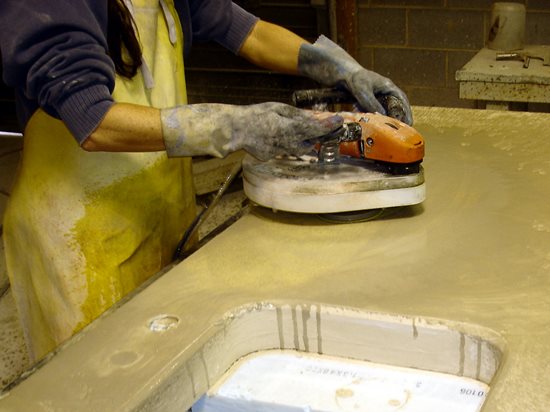- Focus News
-
3 Making Modes of Metal-Bonded Diamond Grinding Wheels
How do I polish a granite edge
- Contact Us
-
Tel:0592-5099391
Fax:0592-5099319
ADD:Unit 2A, Lianchang Building, NO.6-8 Huli Avenue, Huli District,Xiamen,China.
www.stonediamondtool.com

- Details
-
ARE CONCRETE COUNTERTOPS A DIY PROJECT OR SHOULD I HIRE A PRO?
Source:www.stonediamondtool.com Date:2016/10/14 Read:903
How concrete countertops are made
Building a concrete countertop requires more planning and know-how than most typical DIY projects. There are many challenges to building a concrete countertop. If you want a beautiful, durable piece for your home or office, contact a contractor/artisan that specializes in this craft.
Building and reinforcement, and proper concrete mix design are the two biggest issues professional concrete contractors face with concrete countertops. Jeff Girard, founder and president of The Concrete Countertop Institute, offers monthly training classes for contractors, and provides an in-depth website of common questions and answers to countertop challenges.
Proper Materials and ToolsThere are many supplies and tools needed for building a concrete countertop. Some of these include: countertop molds, a casting table, concrete countertop mix, a concrete mixer, reinforcing materials, coloring pigments, knockouts for sinks and faucets, and much more. Concrete countertops require an understanding of proper concrete mix and reinforcement to prevent cracks. It is also useful to have an understanding of countertop sealers. Many experienced contractors design and mix their own sealer combinations for best results—valuable knowledge they have learned from trial and error.
To finish your concrete countertop, you may need to use a polisher to grind the cement to a smoother surface. There are also many other tools and equipment necessary for proper installation. Read this guide for a better idea of what countertop supplies are necessary.
Countertop Weight and InstallationIf you build your own countertops, you will have to decide whether or not to build them in a shop and transport them to their final location, or if you will build them in-place. Oftentimes, building a countertop in-place can be an inconvenience and can make for a messy workspace. However, this is a good solution for building long countertop runs with no seams, or when heavy or oddly-shaped countertops cannot be carried into a home or fit through a doorway. This is also a good solution if your countertop will be located outside, on a barbecue, for instance.
For pre-cast countertops, you will often have more control over the building process. It is easier to mix and use materials without the fear of damaging finished cabinetry or flooring. It also is more of a convenience for giving the countertops plenty of curing time in a location you can secure from dust and debris. The main concern is how you will transport and install the countertops once they are complete. Countertops can be extremely heavy, and often require a crew of people to lift and maneuver into place.
Getting HelpIf you want to build a small outdoor concrete countertop, you might be able to tackle the job yourself, particularly if you plan to have a simple layout, minimal coloring, and finishing. First, though, consult with the manufacturer of your concrete mix and coloring agent. Many are willing to provide detailed application instructions and technical support. There are also many classes offered throughout the U.S. and Canada for basic concrete countertop training.
- News Reviews
- Popular Products
-
- 3 Step Polishing Pad (3SP_01)Clicks:64443
- CUTTING &GRINDING WHEELS (HN1Clicks:61610
- RCB resin copper bond polishinClicks:57842
- 3'' Metal Resin Transitional PClicks:34199
- Fickert Diamond Brush AB05DClicks:21747
- Aluminium Backer Pad BP01Clicks:19631
- Spiral yellow and green Wet PaClicks:19461
- Diamond wet dry core drill bitClicks:18652
- Products Categories
- Brazed Drill Bit Diamond Cutting Tools Diamond Saw Blade Diamond Small Blade Diamond Segment Diamond Wire Saw Electroplated Blade Multi Blades and Single Saws Diamond Polishing Tools Wet Polishing Pads Dry Polishing Pads Concrete Tooling Diamond Profile Wheel Polishing Drum wheel Abrasive Stone For Granite Abrasive Stone For Marble Backer Pads Grinding Discs Diamond Grinding Tools Sintered Cup Wheels Brazed cup wheels Profiling Router Bit Router Bits CNC Profile Wheels CNC Finger Bits Brazed Router Bits Diamond Core Drill Bit Diamond Core Drill Bit Vacuum Brazed Drill Bits Electroplated core bits Construction Core Drill Bit English drill and construstion Drill Dry Diamond Core Drill Bit Diamond Carving Tools Common Carving Tools High-speed Carving Tools Stone Profiler Machines Air Grinder Wet Grinder Angle Grinder Multi Function Wet Grinder Stone Router Machines Abrasive Brush Other Accessories Brush For Floor Series Diamond Brush Series Brush For Steel Wire Series Brush For Rutine Series Bush Hammer Plates Diamond Rollers The thick round Microcement Tools STONE Product
- www.sssto.com | www.chinastonesuppliers.com | www.chinadiamondtool.com | www.chinatoolstore.com | diamond tools supply
- javascript:;
-
-
© 2009-2012 All rights reserved Support:www.zawl.cn
-










